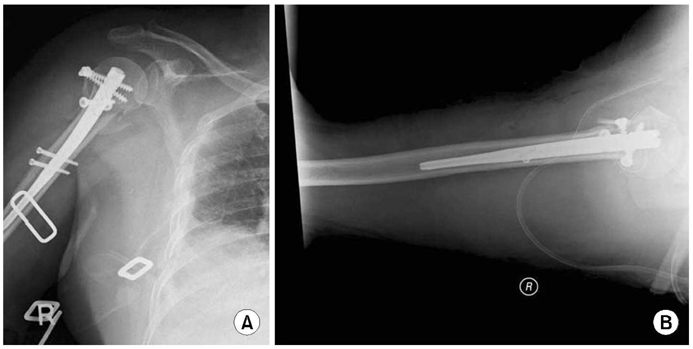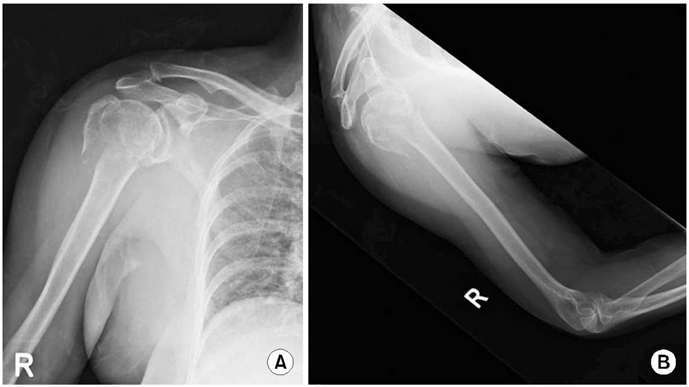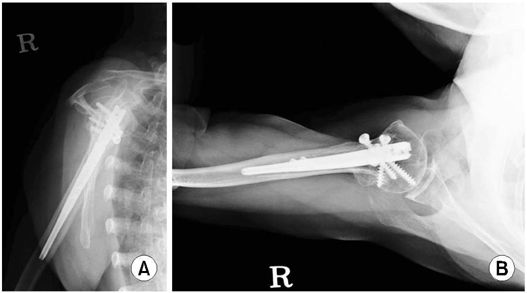J Korean Fract Soc.
2007 Jan;20(1):45-52. 10.12671/jkfs.2007.20.1.45.
Open Intramedullary Nail with Tension Band Sutures & Lock Sutures on Proximal Humeral Three-part Fracture
- Affiliations
-
- 1Department of Orthopaedic Surgery, Yongdong Severance Hospital, Yonsei University College of Medicine, Seoul, Korea.
- 2Department of Orthopaedic Surgery, Konkuk University College of Medicine, Seoul, Korea. drpark@chol.com
- KMID: 2294378
- DOI: http://doi.org/10.12671/jkfs.2007.20.1.45
Abstract
- PURPOSE
To evaluate the results according to the difference of age and bone mineral density (BMD) of the surgical treatments using open intramedullary nail with tension sutures and lock suture on proximal humeral three part fracture.
MATERIALS AND METHODS
30 patients treated by open intramedullary nail with tension band and lock suture technique on proximal humeral fractures were reviewed. After treatment, average follow up periods was 50 months (range; 17~143 month). Postoperative clinical outcome was evaluated using ASES functional score, Neer score and constant score.
RESULTS
Bony union were obtained all except one case. Range of motion, mean forward elevation was 142°, mean external rotation was 56°, mean external rotation at 90° abduction was 68°. Average pain score of visual analog scale was 1.5. Average functional score of American Shoulder and Elbow Society was 86. Average Neer score was 89. Constant score was 85. Pain and functional score of group I were better than those of group, however, there was no statistically significant difference (p>0.05). In the comparison between group III and group IV, the results were same (p>0.05).
CONCLUSION
The patients treated using open intramedullary nailing, tension band and lock suture could enable early ROM exercise and show good clinical results. This treatment method will be useful in old age osteoprorotic patients.
MeSH Terms
Figure
Cited by 1 articles
-
Hemiarthoplasty with Bone Block Graft and Low Profile Prosthesis for the Comminuted Proximal Humerus Fractures
Chung Hee Oh, Joo Han Oh, Sae Hoon Kim, Ki Hyun Jo, Sung Woo Bin, Hyun Sik Gong
J Korean Fract Soc. 2008;21(3):213-219. doi: 10.12671/jkfs.2008.21.3.213.
Reference
-
1. Bhandari M, Matthys G, McKee MD. Evidence-Based Orthopaedic Trauma Working Group. Four part fractures of the proximal humerus. J Orthop Trauma. 2004; 18:126–127.
Article2. Bjorkenheim JM, Pajarinen J, Savolainen V. Internal fixation of proximal humeral fractures with a locking compression plate: a retrospective evaluation of 72 patients followed for a minimum of 1 year. Acta Orthop Scand. 2004; 75:741–745.3. Cornell CN. Tension-band wiring supplemented by lag-screw fixation of proximal humerus fractures: a modified technique. Orthop Rev. 1994; Suppl. 19–23.4. Cox MA, Dolan M, Synnott K, McElwain JP. Closed interlocking nailing of humeral shaft fractures with the Russell-Taylor nail. J Orthop Trauma. 2000; 14:349–353.
Article5. Crates J, Whittle AP. Antegrade interlocking nailing of acute humeral shaft fractures. Clin Orthop Relat Res. 1998; 350:40–50.
Article6. Esser RD. Open reduction and internal fixation of three- and four-part fractures of the proximal humerus. Clin Orthop Relat Res. 1994; 299:244–251.
Article7. Fankhauser F, Boldin C, Schippinger G, Haunschmid C, Szyszkowitz R. A new locking plate for unstable fractures of the proximal humerus. Clin Orthop Relat Res. 2005; 430:176–181.
Article8. Flatow EL, Cuomo F, Maday MG, Miller SR, McIlveen SJ, Bigliani LU. Open reduction and internal fixation of two-part displaced fractures of the greater tuberosity of the proximal part of the humerus. J Bone Joint Surg Am. 1991; 73:1213–1218.
Article9. Frigg R. Development of the locking compression plate. Injury. 2003; 34:Suppl 2. B6–B10.
Article10. Habermeyer P, Schweiberer L. Fractures of the proximal humerus. Orthopade. 1989; 18:200–207.11. Hawkins RJ, Kiefer GN. Internal fixation techniques for proximal humeral fractures. Clin Orthop Relat Res. 1987; 223:77–85.
Article12. Hems TE, Bhullar TP. Interlocking nailing of humeral shaft fractures: the Oxford experience 1991 to 1994. Injury. 1996; 27:485–489.
Article13. Hintermann B, Trouillier HH, Schafer D. Rigid internal fixation of fractures of the proximal humerus in older patients. J Bone Joint Surg Br. 2000; 82:1107–1112.
Article14. Ingman AM, Waters DA. Locked intramedullary nailing of humeral shaft fractures. Implant design, surgical technique, and clinical results. J Bone Joint Surg Br. 1994; 76:23–29.
Article15. Instrum K, Fennell C, Shrive N, Damson E, Sonnabend D, Hollinshead R. Semitubular blade plate fixation in proximal humeral fractures: a biomechanical study in a cadaveric model. J Shoulder Elbow Surg. 1998; 7:462–466.
Article16. Jaberg H, Warner JJ, Jakob RP. Percutaneous stabilization of unstable fractures of the humerus. J Bone Joint Surg Am. 1992; 74:508–515.
Article17. Jakob RP, Miniaci A, Anson PS, Jaberg H, Osterwalder A, Ganz R. Four-part valgus impacted fractures of the proximal humerus. J Bone Joint Surg Br. 1991; 73:295–298.
Article18. King GJ, Richards RR, Zuckerman JD, et al. A standardized method for assessment of elbow function. Research Committee, American Shoulder and Elbow Surgeons. J Shoulder Elbow Surg. 1999; 8:351–354.19. Ko JY, Yamamoto R. Surgical treatment of complex fracture of the proximal humerus. Clin Orthop Relat Res. 1996; 327:225–237.
Article20. Koval K, Sanders R, Zuckerman J, Helfet D, Kummer F, DiPasquale T. Modified-tension band wiring of displaced surgical neck fractures of the humerus. J Shoulder Elbow Surg. 1993; 2:85–92.
Article21. Kristiansen B, Christensen SW. Plate fixation of proximal humeral fractures. Acta Orthop Scand. 1986; 57:320–323.
Article22. Lill H, Hepp P, Korner J, et al. Proximal humeral fractures: how stiff should an implant be? A comparative mechanical study with new implants in human specimens. Arch Orthop Trauma Surg. 2003; 123:74–81.
Article23. Min WK, Sin SJ, Jeon IH, et al. Fixation failure of LCP during the treatment of proximal humerus fractures. J Korean Fract Soc. 2006; 19:188–192.
Article24. Moon ES, Kim MS, Park KS, Chung JY, Lee KB. The treatment of unstable proximal humerus fracture using locking plate. J Korean Fract Soc. 2006; 19:193–200.
Article25. Neer CS 2nd. Displaced proximal humeral fractures. II. Treatment of three-part and four-part displacement. J Bone Joint Surg Am. 1970; 52:1090–1103.26. Neer CS 2nd. Displaced proximal humeral fractures. Part I. Classification and evaluation. 1970. Clin Orthop Relat Res. 2006; 442:77–82.27. Park JY, An JW, Lee SC. Open intramedullary nail with tension band sutures on proximal humeral fracture. J Korean Shoulder Elbow Soc. 2003; 6:149–160.
Article28. Park JY, An JW, Oh JH. Open intramedullary nailing with tension band and locking sutures for proximal humeral fracture: hot air balloon technique. J Shoulder Elbow Surg. 2006; 15:594–601.
Article29. Rajasekhar C, Ray PS, Bhamra MS. Fixation of proximal humeral fractures with the Polarus nail. J Shoulder Elbow Surg. 2001; 10:7–10.
Article30. Resch H, Hubner C, Schwaiger R. Minimally invasive reduction and osteosynthesis of articular fractures of the humeral head. Injury. 2001; 32:Suppl 1. SA25–SA32.
Article31. Resch H, Povacz P, Frohlich R, Wambacher M. Percutaneous fixation of three- and four-part fractures of the proximal humerus. J Bone Joint Surg Br. 1997; 79:295–300.
Article32. Robinson CM, Bell KM, Court-Brown CM, McQueen MM. Locked nailing of humeral shaft fractures. Experience in Edinburgh over a two-year period. J Bone Joint Surg Br. 1992; 74:558–562.
Article33. Rose SH, Melton LJ 3rd, Morrey BF, Ilstrup DM, Riggs BL. Epidemiologic features of humeral fractures. Clin Orthop Relat Res. 1982; 168:24–30.
Article34. Ruch DS, Glisson RR, Marr AW, Russell GB, Nunley JA. Fixation of three-part proximal humeral fractures: a biomechanical evaluation. J Orthop Trauma. 2000; 14:36–40.
Article35. Siegel JA, Dines DM. Proximal humerus malunions. Orthop Clin North Am. 2000; 31:35–50.
Article36. Stableforth PG. Four-part fractures of the neck of the humerus. J Bone Joint Surg Br. 1984; 66:104–108.
Article37. Sturzenegger M, Fornaro E, Jakob RP. Results of surgical treatment of multifragmented fractures of the humeral head. Arch Orthop Trauma Surg. 1982; 100:249–259.
Article38. Szyszkowitz R, Seggl W, Schleifer P, Cundy PJ. Proximal humeral fractures. Management techniques and expected results. Clin Orthop Relat Res. 1993; 292:13–25.39. Walch G, Boulahia A, Boileau P, Kempf JF. Primary glenohumeral osteoarthritis: clinical and radiographic classification. The Aequalis Group. Acta Orthop Belg. 1998; 64:Suppl 2. 46–52.40. Wanner GA, Wanner-Schmid E, Romero J, et al. Internal fixation of displaced proximal humeral fractures with two one-third tubular plates. J Trauma. 2003; 54:536–544.
Article
- Full Text Links
- Actions
-
Cited
- CITED
-
- Close
- Share
- Similar articles
-
- Humeral intramedullary nail bending following trauma: a case report
- Periprosthetic Fracture after Proximal Humeral Intramedullary Nail, Treated by Functional Bracing: A Case Report
- Polarus Intramedullary Nail for Proximal Humeral and Humeral Shaft Fractures in Elderly Patients with Osteoporosis
- Treatment of Proximal Humeral Fractures using Modified Steinmann Pins and Tension Band Wiring
- Longitudinal Supraspinatus Tear Associated with Antegrade Humeral Intramedullary Nailing: A Case Report and Literature Review with Focus Placed on Nail Entry Point






